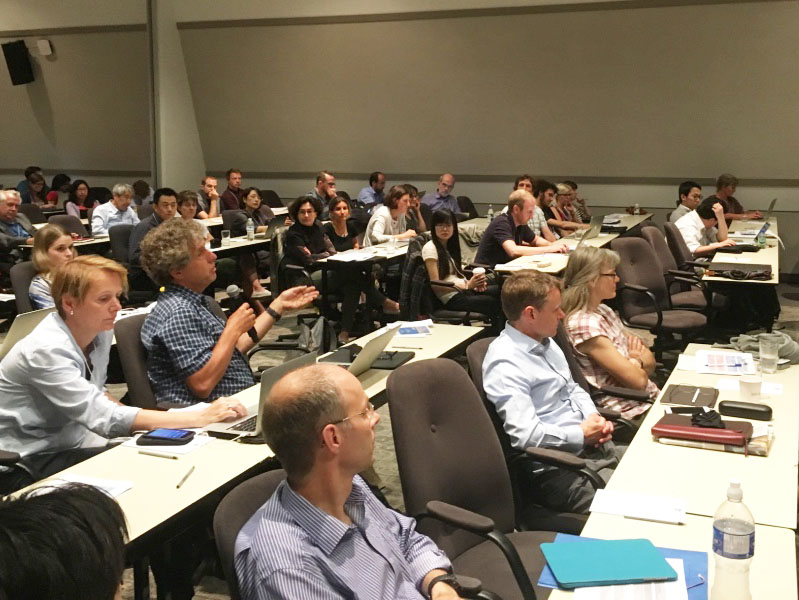 The 5th Working Group on Numerical Experimentation (WGNE) "Workshop on systematic errors in weather and climate models" was held from 19-23 June 2017 in Montréal, Québec, Canada and jointly sponsored by WCRP, the World Meteorological Organization (WMO), Environment and Climate Change Canada, Ouranos Consortium on Regional Climatology and Adaptation to Climate Change and the National Oceanic and Atmospheric Administration (NOAA) Modeling, Analysis, Predictions, and Projections (MAPP) Program. The event was attended by 200 people from 37 countries.
The 5th Working Group on Numerical Experimentation (WGNE) "Workshop on systematic errors in weather and climate models" was held from 19-23 June 2017 in Montréal, Québec, Canada and jointly sponsored by WCRP, the World Meteorological Organization (WMO), Environment and Climate Change Canada, Ouranos Consortium on Regional Climatology and Adaptation to Climate Change and the National Oceanic and Atmospheric Administration (NOAA) Modeling, Analysis, Predictions, and Projections (MAPP) Program. The event was attended by 200 people from 37 countries.
The principal goal of the workshop was to increase understanding of the nature and cause of errors in models used for weather and climate prediction, including intra-seasonal to inter-annual scales. Of special interest were studies that consider errors found in multiple models and errors which are present across timescales. Diagnostics and metrics to identify and characterize systematic errors were particularly welcome.
Considering recent reports from WGNE members, affiliated centres and groups, WGNE had identified some processes that models currently fail to represent accurately.
After a welcome address by WGNE Co-chairs Dr Ayrton Zadra (local host)and Keith Williams and a general introduction by Dr Michel Rixen from WMO, the workshop continued around the following themes:
- Atmosphere-land-ocean-cryosphere interactions: errors in the representation of surface fluxes and drag processes; stable boundary layer issues; impact of coupled modeling.
- Clouds and precipitation: cloud-radiative feedback problem; tropical convection issues; representation of low clouds, especially at high latitudes; excess low accumulations of precipitation; underestimation of precipitation extremes; summer continental precipitation; precipitation over orography.
- Resolution issues: dependence of systematic errors on model resolution; grey zones of physical parametrizations.
- Teleconnections: errors in the simulation of interactions between high-latitudes, mid-latitudes and tropics.
- Metrics and diagnostics: emphasis on novel techniques (e.g. process-based diagnostics; use of data assimilation or coupled modeling) to diagnose and measure systematic errors.
- Model errors in ensembles: characterization of ensemble spread and identification of systematic errors in multi-model ensembles and ensemble prediction systems; evaluation of stochastic representations.
A number of early career scientist activities were organized during the week, including:
- Best Poster Award Competition:
- Falko Judt for his work entitled "Effect of Model Error on the Predictability of Hurricane Intensity"
- Ying Ying Toh for her work entitled "Maritime Continent seasonal climate biases in AMIP experiments of the CMIP5 multimodel ensemble"
- Danahé Paquin-Ricard for her work entitled "Role and Impact of a Deep Convective Parameterization on Km- Scale Atmospheric Forecasts"
- A meet and greet lunch with senior experts, including Greg Flato, Chair WGCM and Co-chair Intergovernmental Panel on Climate Change Working Group I, Keith Williams, co-chair WGNE and Michel Rixen, Senior Scientific Officer at WCRP/WMO
- Session rapporteur role: highlights of each session were presented by young scientists during the closing session on the last day of the conference and will form the basis of a peer-reviewed paper summarizing the main findings of the workshop
- A "Pub night" where all early careeer scientists were invited
Irina Sandu (winner of the WCRP/WWRP International Prize on Model Development 2016) talked about the importance of surface drag on the circulation and showed why the prize selecction committee were impressed by her outstanding contribution in the field of weather and climate model development.
Mr David Grimes, President of WMO, Assistant Deputy Minister and head of Environment and Climate Change Canada's Meteorological Service provided a welcome address to all participants, stressing the importance of numerical modeling across all time scales for the whole WMO enterprise. He highlighted polar issues as another crucial science challenge. He finally briefed participants on the current WCRP sponsors' review and broader on-going discussions to re-visit the structure and governance of research within the Organization.
The closing session identified the following draft recommendations:
- WGNE-WGCM to prioritise errors.
- Extend drag project to consider momentum more generally and consider representation of orography, etc.
- Consider setting up a group or extend drag group to look at surface flux errors.
- Encourage community to make use of WGSIP database on shocks and initial drifts in subseasonal, seasonal and decadal climate predictions
- Discuss with Subseasonal-to-Seasonal (S2S) Prediction Project / Working Group on Subseasonal to Interdecadal Prediction (WGSIP) regarding extension of aerosols project to subseasonal to seasonal timescale.
- Consider a cross weather-climate group looking at initial tendency analysis of common biases.
- Hold another WSE in 4-5 years time, possibly inviting submissions on solutions rather than just problems.
For more details, see the workshop webpages.
The Working Group on Numerical Experimentation (WGNE), jointly established by the WCRP Joint Scientific Committee (JSC) and the WMO Commission for Atmospheric Sciences (CAS), which is responsible for the World Weather Research Programme (WWRP) and the Global Atmosphere Watch (GAW) Programme, has the responsibility of fostering the development of atmospheric circulation models for use in weather, climate, water and environmental prediction on all time scales and diagnosing and resolving shortcomings.

